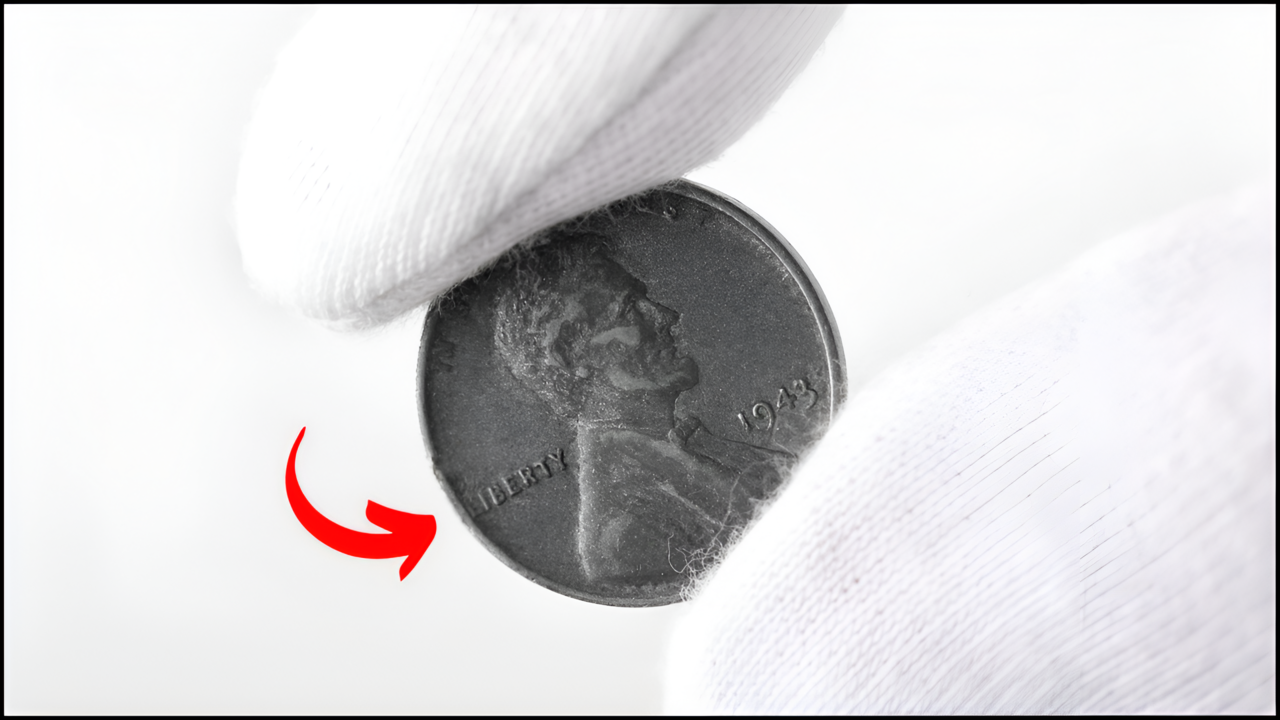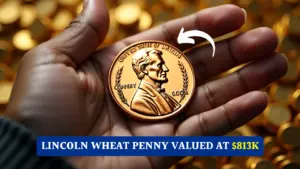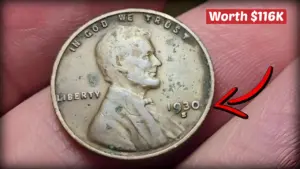The Lincoln Wheat Penny, a coin minted between 1909 and 1958, holds a unique place in the world of numismatics. Revered by both novice and expert collectors, this penny stands out not only because of its distinctive design but also due to its historical significance. Featuring President Abraham Lincoln on the obverse and two wheat stalks on the reverse, it symbolizes a chapter of American history that’s treasured by many. While most Wheat Pennies are worth just a few cents above their face value, a select few have garnered the attention of enthusiasts and auction houses alike, sometimes fetching astronomical prices one such coin being rumored to be worth up to $750,000.
The intrigue surrounding the Lincoln Wheat Penny is fueled by rare variations, historical anomalies, and the possibility however slim of stumbling upon one of these treasures in everyday circulation. Let’s delve deeper into the story of this iconic coin, exploring its origins, the reasons behind its value, and whether such a remarkable piece might still be lurking in someone’s loose change.
The Legacy of the Lincoln Wheat Penny
The journey of the Lincoln Wheat Penny began in 1909, the centennial year of President Abraham Lincoln’s birth. For the first time in American history, a president’s portrait was featured on a coin intended for general circulation. The decision to place Lincoln on the penny was both a tribute to his enduring legacy and a reflection of a changing era in U.S. coinage.
Designed by Victor David Brenner, a Lithuanian-born artist and engraver, the obverse of the coin features a detailed depiction of Lincoln, which was based on a plaque Brenner had created years earlier. The reverse design, meanwhile, incorporates two stalks of wheat framing the words “ONE CENT” and “UNITED STATES OF AMERICA.” This choice of imagery was symbolic, representing prosperity and the country’s agricultural roots. The phrase “E Pluribus Unum,” meaning “Out of many, one,” further emphasizes the spirit of unity.
The Lincoln Wheat Penny replaced the Indian Head Penny and was produced until 1958, after which the reverse design was updated to feature the Lincoln Memorial. Over its nearly 50-year production span, the Wheat Penny underwent various changes in composition, mint locations, and minor design adjustments, each contributing to its rich history.
Rare and Valuable Variations
Not all Lincoln Wheat Pennies are created equal. While the vast majority hold sentimental value or serve as historical keepsakes, certain variations and errors have turned ordinary-looking coins into extraordinary collectibles. Among the millions of Wheat Pennies minted, a few stand out due to their rarity and unique characteristics.
One of the most coveted examples is the 1943 Copper Wheat Penny. During World War II, the U.S. Mint opted to conserve copper for military purposes, resulting in pennies being produced from zinc-coated steel. However, a small number of copper planchets from 1942 inadvertently made their way into the production line, leading to the creation of these highly prized coins. With only around 20 known examples in existence, the 1943 Copper Penny has fetched prices exceeding $1 million at auctions.
Another iconic variation is the 1909-S VDB Wheat Penny. The “S” refers to the San Francisco Mint where the coin was produced, while “VDB” are the initials of the designer, Victor David Brenner. Initially, these initials were prominently displayed on the reverse side of the coin, which drew public criticism for being too conspicuous. The U.S. Mint quickly removed the initials, resulting in a limited number of 1909-S VDB pennies being circulated. These coins are now considered a must-have for serious collectors.
Additional rarities include error coins such as doubled-die pennies, which display noticeable doubling in certain elements of the design, as well as coins with repunched mint marks. These anomalies, though unintentional, add a layer of intrigue and value to the Lincoln Wheat Penny collection.
The $750,000 Lincoln Wheat Penny
The notion of a Lincoln Wheat Penny being worth $750,000 may sound incredible, but it is not without precedent. This staggering valuation is often associated with coins like the 1943 Copper Penny or other rare error coins. The precise worth of any Wheat Penny depends on factors such as its rarity, condition, and provenance. Coins graded in mint or near-mint condition, especially those verified by professional grading services, tend to command higher prices.
In 2019, a 1943 Copper Wheat Penny was sold for $204,000, further cementing its status as one of the most valuable coins in U.S. history. While the $750,000 figure may apply to exceptional circumstances such as an extremely rare variation in flawless condition it underscores the immense allure of these coins among collectors.
Are These Pennies Still in Circulation?
Given the passage of time and the efforts of collectors, finding a high-value Wheat Penny in circulation is a rarity but not an impossibility. Some Wheat Pennies continue to surface in rolls of coins from banks, jars of spare change, or even at garage sales. While the likelihood of encountering a $750,000 coin is slim, the possibility adds a layer of excitement to the hobby of coin collecting.
It’s worth noting that even common Wheat Pennies can hold modest value, particularly if they are from earlier years or in excellent condition. Checking your pocket change or starting a penny roll hunt might just lead to an unexpected discovery.
Tips for Collectors
For those intrigued by the Lincoln Wheat Penny and its potential value, here are some tips to get started:
- Educate Yourself on Key Dates and Errors: Familiarize yourself with the rarest coins, such as the 1943 Copper Penny, the 1909-S VDB Penny, and doubled-die errors. Knowing what to look for can help you identify valuable coins.
- Use High-Quality Tools: A magnifying glass or jeweler’s loupe is essential for spotting fine details, especially errors or mint marks.
- Protect Your Finds: Once you’ve identified a coin of interest, store it properly to prevent damage. Coin holders, albums, or airtight capsules are ideal for preservation.
- Consult Experts: If you believe you’ve found a rare coin, seek authentication and grading from reputable organizations such as the Professional Coin Grading Service (PCGS) or the Numismatic Guaranty Company (NGC).
- Start Small: Coin collecting can be an affordable hobby. Begin with common Wheat Pennies and gradually work your way toward rarer finds as your knowledge and interest grow.
Conclusion
The Lincoln Wheat Penny is far more than a simple one-cent coin. It is a tangible piece of history, a reflection of the craftsmanship of its time, and a source of fascination for generations of collectors. From its humble origins to its rare and valuable variations, the Wheat Penny continues to captivate those who appreciate the stories behind the coins in their hands.
While finding a $750,000 Wheat Penny in your pocket change is a long shot, the adventure of searching for hidden treasures and building a collection is priceless. Whether you’re a seasoned numismatist or a beginner curious about the world of coins, the Lincoln Wheat Penny offers an exciting gateway into the rich history of American coinage. Who knows? That unassuming penny in your jar might just be the key to unlocking a remarkable story.
F&Q
Q: What years was the Lincoln Wheat Penny minted?
A: It was minted from 1909 to 1958.
Q: Why is the 1943 copper Wheat Penny so valuable?
A: It’s rare because most pennies that year were made of steel, not copper.
Q: Who designed the Lincoln Wheat Penny?
A: Victor David Brenner designed it.
Q: What is the highest recorded value of a Wheat Penny?
A: Some rare examples have sold for up to $750,000.
Q: Where might someone still find a rare Wheat Penny today?
A: In old coin jars, pocket change, or inherited collections.


